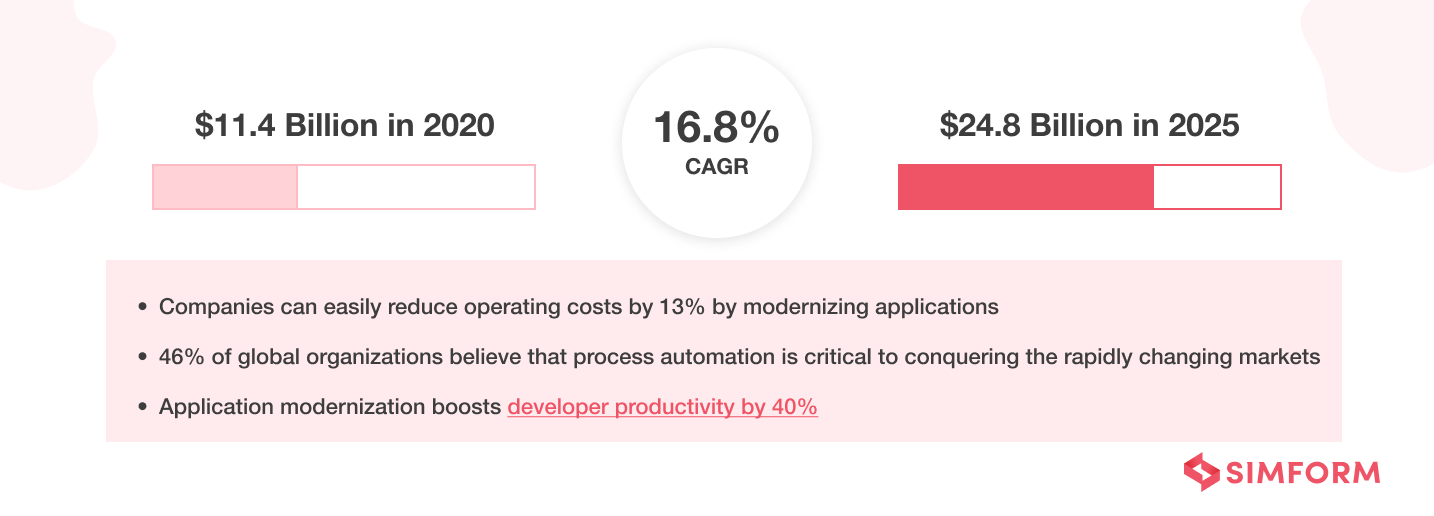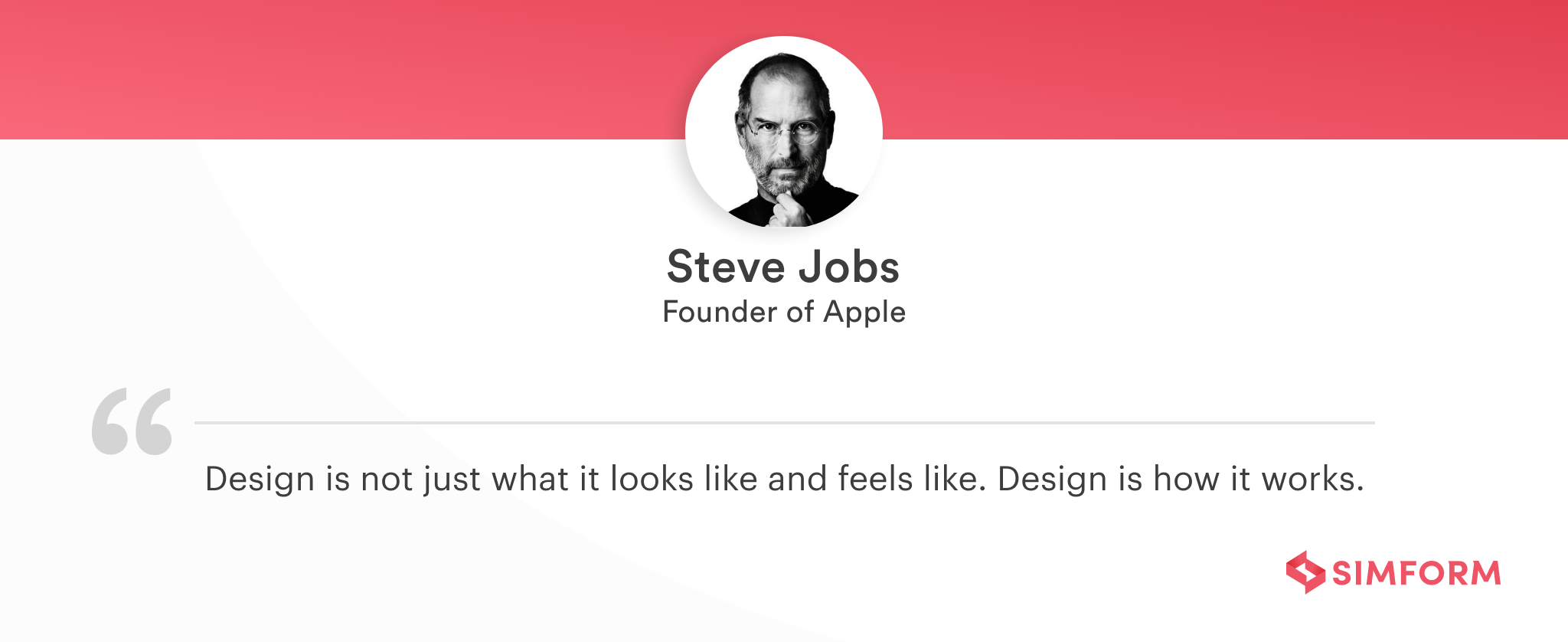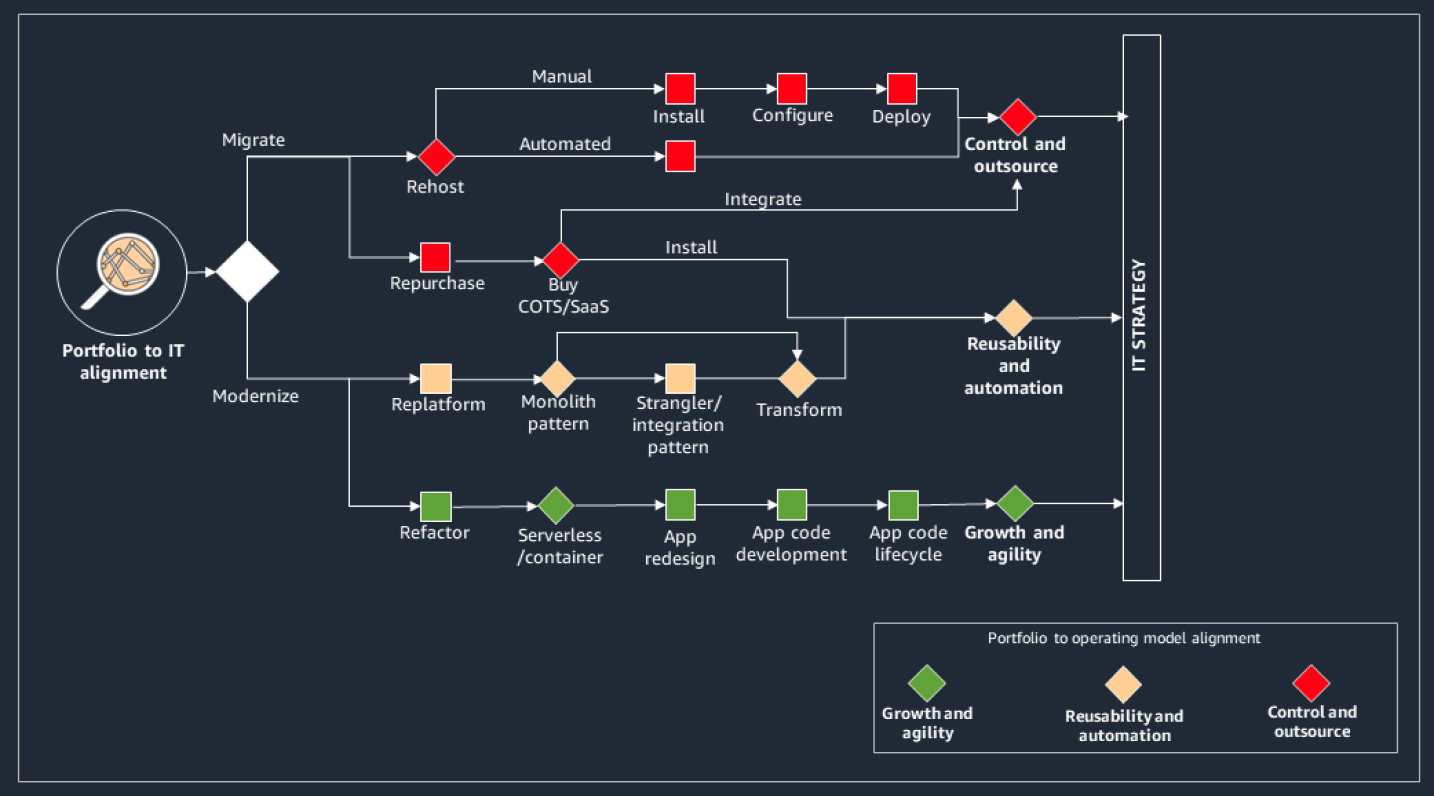Transforming monolithic systems with new features and services that align with the current market trends improves processes and business productivity. So, it is no surprise that modernizing applications is becoming a top priority for enterprises across the globe. In fact, around 80% of legacy applications will be modernized in the next five years.
Following suit and achieving increased efficiency and speed, Goldman Sachs can swear by the benefits of application modernization. The global investment bank integrated GitLab to combine different parts of the development lifecycle into a single ecosystem.
As a result, its engineering teams move faster from a weekly release cycle to once every few minutes, pushing the teams to production in less than 24 hours.
So should you also modernize your legacy system?
Before I convince you why you should, let’s know the umbrella term – Application Modernization.
Application Modernization – An Overview
Application modernization addresses the migration of legacy to new applications by integrating new functionalities. It lets organizations update older software for newer computing approaches, including newer languages, frameworks, and infrastructure platforms. Overall, app modernization enables enterprises to improve an existing system’s security, integrity, and overall efficiency rather than replacing it entirely.
To get a clear idea of the modernization process, refer to below diagram:
Need to modernize applications
Running an old legacy system or outdated application poses multiple challenges if not aligned with business goals. It may not receive security patching updates, leaving them vulnerable to bugs and virus attacks that disrupt the system’s performance.
Moreover, it contains security risks as the company or vendor no longer supports them. In addition, legacy systems need expensive upkeep for an enterprise to keep them running.
Know the sureshot strategy for app modernization on AWS Cloud
The simple solution to the above issues is to replace an enterprise’s current legacy systems, but it is a little more complex approach than it seems. That’s where application modernization lends a helping hand.
Application modernization benefits
Enterprises are focusing more on upgrading enterprise applications with new infrastructure to achieve modernization goals. Here a robust strategy for modernizing apps allows them to go to market faster by reducing maintenance costs, enhancing accessibility to the latest data, and increasing profits.

There are innumerable business benefits of modernizing existing apps. However, here we are listing only the prominent ones:
1. Productivity boost
Training software developers and teams to operate legacy systems is an expensive and time-taking process. Moreover, some outdated apps can’t automate repetitive tasks and integrate new processes. This makes engineering teams less productive.
Application modernization ties different parts of the development lifecycle into one consistent ecosystem. It allows employees to work on different tasks simultaneously, enhancing the time-to-market.
In addition, the modernized applications have advanced features and tools that enable operational simplicity and are used without complex training, eventually increasing employee productivity.
2. Reduced operational costs and tech debt
A considerable maintenance investment makes legacy applications unfeasible for organizations. Plus, they are hosted in on-premise data centers that are expensive, and often have insufficient documentation, making it hard to add new features. So, naturally, what these applications ultimately get is high tech debt.
On the contrary, modernization lets an enterprise harness the potential of the private cloud to entertain emerging digital business demands. Also, there is no need for a separate data center as cloud databases offer a pay-as-you-go model where you have to pay only for the services you use.
DevOps implementation significantly helps streamline operations and reduce costs with fine-tuned CI/CD pipelines, more agile release cycles, and continuous improvements across all development processes.
3. Improved business agility
Traditionally, developers need to spin up monolithic environments to make any changes, update the code, the server, and all the configurations within it. Thanks to app modernization, one no longer has to spin down servers or plan major release updates as the application is dispersed into multiple independently managed workloads.
Pinterest managed to handle a user base of 17 million from 50,000 in just nine months by scaling its processing and storage activities to AWS.
4. Scalability
When the global tech landscape changes rapidly, constant upgradation is the only way to survive and succeed. Businesses need to adapt and grow both physically and technologically to move forward, take on competitors, and drive more revenue.
But with legacy systems, adding new features or functionalities becomes challenging. That’s why businesses need storage solutions that can accommodate changing requirements. With the scalability provided by the cloud, businesses can add or reduce IT resources to accommodate larger or smaller loads.
5. Additional revenue streams
Modernizing applications can help firms generate more income by introducing new services or procedures that can better their offerings. For example, most companies offer online payment options or chat and support via social media apps. Brands are introducing VR games to promote their products and earn additional revenue.
For example, Nike created Nikeland, a Roblox VR game where users can play games and customize their avatars in Nike-branded sneakers and apparel. The best thing is that it has helped Nike attract nearly 7 million global visitors, which is 26% of its total revenue.
6. Keeping up with the latest market trends
Legacy system modernization allows companies to update their older systems with the latest technologies and features. It lets the organizations merge the relevant components from the current ones without starting from scratch. Moreover, it enables organizations to make the most of key technologies like Big Data, Machine Learning, Artificial Intelligence, and the Cloud.
Enterprises can use AI and Machine Learning technologies in customer service. With personalization becoming a key differentiator for enterprises, one of the key benefits of modernization is predictive analytics. It facilitates natural language processing for chatbots and voice and text analysis.
7. Better support and maintenance
As legacy applications grow increasingly out-of-date, companies spend vast amounts to keep them alive. Such apps can accumulate bugs and rely on old codes that are costlier to maintain.
Upgrading apps can help with support and maintenance. Here’s how:
- In modernization, legacy logic and code are migrated to a new platform. So it becomes easier to align application infrastructure with the latest technologies and trends
- App modernization allows companies to update their legacy systems with the latest technology stack aligned with their business goals.
- Modernization makes it easier to implement source code changes, migrate databases, and write documentation
- One can leverage containerization and orchestration to set the desired state for modern applications
- Modernization employs a re-engineering approach that contains data and coding restrictions to prevent the system solution from vulnerabilities
8. Enhanced security
Security is one of the prime concerns behind modernizing the legacy platform infrastructure. Vendors do not support outdated applications, which eventually causes data breaches and malware attacks.
Modernization provides a business entity with better security and protection for critical transactions. It offers state-of-the-art DDoS protection, security upgrades, and Application Delivery Controllers (ADCs) to safeguard an organization’s infrastructure from the most advanced threats.
It enables users to use secure web application firewalls and bot management solutions to protect applications and data from cybercriminals.
9. Improved user experiences
Flexible digital experiences have become the need of the hour for web or mobile applications. This need makes user experience, aka UX, a core aspect of legacy modernization.

The modernization approach helps redesign the user-facing elements of a legacy system, ensuring that the new one provides better access to information and enables users to perceive, understand, navigate, and interact with a system or app.
In addition to perfect colors and screen orientation, modernization combines icons, font style, size, and other visual components to create a unique look and feel for the application. All such things will improve your user experience in the long run.
Reap application modernization benefits with Simform!
Using outdated technologies or legacy systems can be problematic, especially when they fail to meet modern business requirements. Application modernization is vital in accelerating the digital transformation journey. It eliminates the need to add new hardware, modify existing operations, or rewrite codes from scratch.
When modernizing an application, one needs to be confident about the business and technical value it brings to your organization. They can use any of the following application modernization strategies to give a modern touch to legacy systems:
- Break down the monolith into manageable microservices
- Containerize all critical applications
- Become responsive to the demands of current times and the near future
At Simform, we believe in delivering robust end-to-end application modernization by re-architecting your legacy application and migrating its code to a new platform to serve your business capabilities best.
Recently, for one of our esteemed clients, iHealth, we integrated a modular architecture to reduce compilation times and increase code reusability. Learn more about iHealth’s app modernization journey. Feel free to share your ideas with us in the comments!
